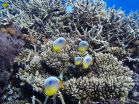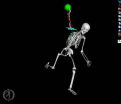INFORMATION:
The research was carried out by researchers from the RIKEN Structural Biology Laboratory, RIKEN Center for Life Science Technologies, along with colleagues from the University of Tokyo.
Obesity-related receptors have a unique structure
2015-04-08
(Press-News.org) A collaboration led by Shigeyuki Yokoyama of RIKEN and Takashi Kadowaki and Toshimasa Yamauchi of the University of Tokyo has used the SPring-8 synchrotron facility in Harima, Japan to elucidate the structure of two receptors of adiponectin, a protein that is associated with obesity and diabetes. The researchers hope that in the future this work, which was published in Nature today, will pave the way toward designing drugs that target these two receptors, AdipoR1 and AdipoR2, to reduce the early mortality associated with diabetes.
Adiponectin, a hormone secreted by fat cells, is known to be involved in the regulation of glucose and fatty acid oxidation. Its levels are reduced in patients with both type 1 and type 2 diabetes, and giving the hormone to mice has been reported to improve glucose intolerance. In addition, administration of a recently discovered adiponectin receptor agonist, AdipoRon, to genetically obese mice led to improved glucose intolerance and longer lifespans.
Since adiponectin binds to two receptors, AdipoR1 and AdipoR2, Yokoyama, who leads the RIKEN Structural Biology Laboratory, and his team surmised that understanding how this binding takes place could contribute to the creation of drugs that target these receptors. Adiponectin receptors are evolutionarily conserved in many living beings, including mammals, plants, and yeasts, so it seemed clear that they should play an important biological role.
Using the microfocus beamline at the SPring-8 synchrotron facility, the group obtained crystallographic images of the two receptors at resolutions of just 2.9 and 2.4 angstroms, and came up with a surprising finding. The structure of the receptors was found to be a completely new type that is unlike G protein-coupled receptors, the most common type of receptor targeted by drug therapies. Intriguingly, the receptors were found to incorporate a zinc ion held in place by three histidine amino acid residues.
They also discovered that the receptors have large internal cavities, whose function is unknown, though Yokoyama speculates that they might be used as the entrance and exits for the substrates and products of the receptors' activities.
According to Yokoyama, "Analyzing the structure of these two receptors provided us with a number of interesting surprises. We believe that this new information on the structure of the adiponectin receptors will help us understand new relationships between the structure and functions of these important receptors, which we know to be evolutionarily conserved, and hopefully will contribute to the development of new adiponectin receptor agonists that can be used for the treatment of obesity-related diseases such as type 2 diabetes. The discovery of the presence of a zinc ion is also fascinating, though more work will be required to understand its significance."
ELSE PRESS RELEASES FROM THIS DATE:
In first human study, new antibody therapy shows promise in suppressing HIV infection
2015-04-08
In the first results to emerge from HIV patient trials of a new generation of so-called broadly neutralizing antibodies, Rockefeller University researchers have found the experimental therapy can dramatically reduce the amount of virus present in a patient's blood. The work, reported this week in Nature, brings fresh optimism to the field of HIV immunotherapy and suggests new strategies for fighting or even preventing HIV infection.
In a person infected with HIV, there is an ongoing arms race between the virus and the body's immune system. Even as the body produces new ...
First look at 'wasabi receptor' brings insights for pain drug development
2015-04-08
In a feat that would have been unachievable only a few years ago, researchers at UC San Francisco have pulled aside the curtain on a protein informally known as the "wasabi receptor," revealing at near-atomic resolution structures that could be targeted with anti-inflammatory pain drugs.
Officially named TRPA1 (pronounced "trip A1"), the newly visualized protein resides in the cellular membrane of sensory nerve cells. It detects certain chemical agents originating outside our bodies--pungent irritants found in substances ranging from wasabi to tear gas--but is also triggered ...
Scientists predict gradual, prolonged permafrost greenhouse gas emissions
2015-04-08
A new scientific synthesis suggests a gradual, prolonged release of greenhouse gases from permafrost soils in Arctic and sub-Arctic regions, which may afford society more time to adapt to environmental changes, say scientists in an April 9 paper published in Nature.
"Twenty years ago there was very little research about the possible rate of permafrost carbon release," said co-author A. David McGuire, U.S. Geological Survey senior scientist and climate modeling expert with the Institute of Arctic Biology at the University of Alaska Fairbanks. "In 2011, we assembled an ...
Recipe for saving coral reefs: Add more fish
2015-04-08
Fish are the key ingredients in a new recipe to diagnose and restore degraded coral reef ecosystems, according to scientists from the Australian Institute of Marine Science, WCS, James Cook University, and other organizations in a new study in the journal Nature.
For overfished coral reef systems, restoring fish populations that perform key roles will in turn restore ecological functions critical to recovery. For moderately or lightly fished reefs, the recipe requires knowing which fish to catch, how many, and which to leave behind.
The authors assessed fish biomass ...
Muscles matter in baseball
2015-04-08
EVANSTON, Ill. --- A new approach to analyzing baseball-pitching biomechanics may one day give players more personalized feedback and help prevent elbow injuries.
In a computer simulation study of baseball pitching, Northwestern University biomedical engineers found that the strength of the elbow muscles of a baseball pitcher likely play a bigger role in injury risk and prevention than previously thought.
The motion analysis approach currently used in the baseball industry to provide athletes with injury-risk feedback is not sophisticated enough to estimate what an ...
Too many obstetrics beds in NYC hospitals: Cost to city is $26.4 million per year
2015-04-08
April 8, 2015--Researchers at Columbia University's Mailman School of Public Health and Columbia Business School studied bed capacity --measured by the number of staffed beds -- in New York City hospital obstetrics units and found a significant excess number of beds, which overall cost the city an estimated $26.4 million each year. The findings, coupled with the current trends of an aging population and the declining birth rate, suggest that many obstetrics units could reduce their bed capacity and still assure timely access to care. Study findings are published in the ...
Biologists identify brain tumor weakness
2015-04-08
CAMBRIDGE, Mass--Biologists at MIT and the Whitehead Institute for Biomedical Research have discovered a vulnerability of brain cancer cells that could be exploited to develop more-effective drugs against brain tumors.
The study, led by researchers from the Whitehead Institute and MIT's Koch Institute for Integrative Cancer Research, found that a subset of glioblastoma tumor cells is dependent on a particular enzyme that breaks down the amino acid glycine. Without this enzyme, toxic metabolic byproducts build up inside the tumor cells, and they die.
Blocking this enzyme ...
Increase in inflammation linked to high traffic pollution for people on insulin
2015-04-08
BOSTON (April 8, 2015) -- A two-year epidemiological study of Puerto Rican adults with type 2 diabetes in the greater Boston area who were using insulin and lived next to roads with heavy traffic had markedly increased C-reactive protein, a marker of inflammation, compared to those living in lower traffic areas. Individuals taking oral diabetes medications did not experience increases in CRP concentration. The study, published online in Environmental Pollution, builds on the research team's previous work suggesting that oral diabetes medications may provide a protective ...
California's solar incentive program has had only modest impact on adoption rates
2015-04-08
Since 2007, California has had one of the most aggressive incentive programs in the country for putting solar-electric panels on the rooftops of homes and businesses. Its $2.2 billion California Solar Initiative (CSI)has provided a per-watt rebate for installing residential and commercial photovoltaic systems. During this period, the solar industry in the state has experienced double-digit growth and to date has installed more than 245,000 systems capable of producing 2,365 megawatts of electricity.
As a result, CSI has been widely touted as a major success. However, ...
Could a dose of nature be just what the doctor ordered?
2015-04-08
Numerous studies over the past 30 years have linked exposure to nature with improved human health and well-being. These findings are of growing importance: In the near future, 70% of the world's population will live in cities, where they will face a rising tide of lifestyle-related disease. Still, little is known about the mechanisms underlying the nature-health connection, and confusion awaits those who would transform existing findings into action.
In the June issue of BioScience, a group of biologists and public health experts led by Danielle F. Shanahan address this ...


